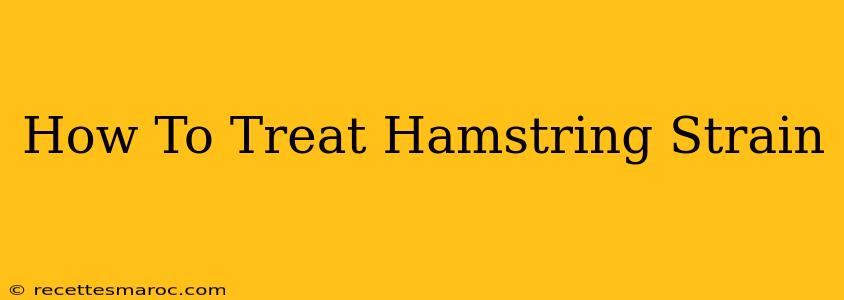A hamstring strain, that agonizing pull in the back of your thigh, is a common injury affecting athletes and non-athletes alike. Understanding how to treat a hamstring strain effectively is crucial for a speedy recovery and preventing future occurrences. This comprehensive guide will walk you through the essential steps.
Understanding Hamstring Strains
Before diving into treatment, let's clarify what a hamstring strain actually is. Your hamstrings are a group of three muscles – the biceps femoris, semitendinosus, and semimembranosus – that run along the back of your thigh. A strain occurs when one or more of these muscles are overstretched or torn. The severity ranges from mild (Grade 1) to severe (Grade 3), with Grade 3 involving a complete tear.
Symptoms of a Hamstring Strain:
Recognizing the symptoms is the first step in effective treatment. Common signs include:
- Sudden pain: A sharp, stabbing pain in the back of your thigh.
- Muscle tightness: Difficulty straightening your leg or bending your knee.
- Swelling and bruising: May develop within hours or days.
- Muscle weakness: Inability to fully use your leg.
- Limited range of motion: Pain or difficulty moving your leg.
- A popping sensation: Sometimes felt at the time of injury.
Note: If you experience severe pain, significant swelling, or inability to bear weight, seek immediate medical attention.
Immediate Treatment (The PRICE Method)
The first 24-48 hours after injury are critical. Following the PRICE method can significantly reduce inflammation and pain:
- Protection: Avoid activities that aggravate the injury. Use crutches if necessary to keep weight off the affected leg.
- Rest: Allow your hamstring adequate time to heal. Avoid strenuous activities.
- Ice: Apply ice packs for 15-20 minutes at a time, several times a day. This helps reduce swelling and inflammation. Never apply ice directly to the skin; wrap it in a thin towel.
- Compression: Use a compression bandage to help control swelling and provide support. Don't wrap it too tightly, as this can restrict blood flow.
- Elevation: Keep your leg elevated above your heart whenever possible to minimize swelling.
Later Stages of Hamstring Strain Treatment
Once the initial inflammation subsides (typically after 2-3 days), you can gradually begin more active treatment:
Gentle Stretching and Exercises:
- Start slowly: Begin with very gentle stretches, holding each for 15-30 seconds. Avoid any movements that cause pain.
- Progress gradually: As your pain decreases, you can gradually increase the intensity and duration of your stretches.
- Strengthening exercises: Once you can comfortably stretch without pain, incorporate exercises to strengthen your hamstrings. This is crucial to prevent future injuries. Your physiotherapist can guide you with specific exercises.
Physical Therapy:
A physical therapist can provide personalized guidance on stretching, strengthening, and other therapeutic exercises to promote healing and improve flexibility and strength. They can also identify underlying issues contributing to the injury.
Medication:
Over-the-counter pain relievers like ibuprofen or naproxen can help manage pain and inflammation. In some cases, your doctor might prescribe stronger pain medication or muscle relaxants.
Preventing Future Hamstring Strains
Prevention is key! Here are some strategies to reduce your risk of future hamstring strains:
- Warm-up properly: Always warm up before any physical activity to prepare your muscles for exercise.
- Cool-down properly: After exercise, cool down with gentle stretching to help your muscles recover.
- Strengthen your hamstrings: Regular hamstring strengthening exercises will improve muscle strength and endurance.
- Improve flexibility: Good flexibility can reduce the risk of muscle strains.
- Use proper technique: Pay attention to your form during exercise and activities to avoid overstretching or straining your hamstrings.
- Listen to your body: Don't push yourself too hard, especially when you're starting a new exercise program. Rest when you need it.
When to See a Doctor
Consult a doctor or physical therapist if:
- Your pain is severe or doesn't improve after a few days of home treatment.
- You have significant swelling or bruising.
- You can't put weight on your leg.
- You hear a popping sound during the injury.
By following these steps and seeking professional help when necessary, you can effectively treat your hamstring strain and return to your normal activities as quickly and safely as possible. Remember, patience and consistency are crucial for a full recovery.

